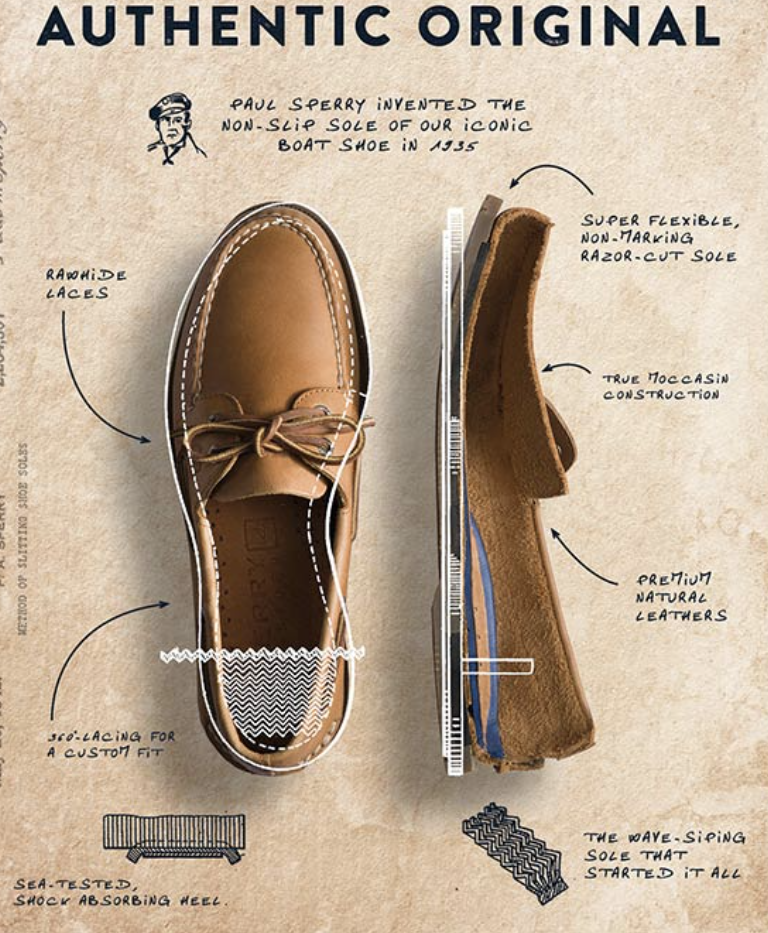Origins of the Sperry Boat Shoe

One of my fondest summer memories was back in the late 1960s when my brother and I took sailing lessons at Pelican Harbor in Miami's Biscayne Bay. Our mom outfitted us in matching blue bathing suits and white Sperry canvas boat shoes. Boy, did we feel just like real sailors tacking and jibing around the Bay in our little fiberglass Sunfish sailboat.
A decade later at the University of Virginia, I discovered the brown leather Sperry Top-Sider. The wooden floors at dear old Theta Chi were incredibly slippery on Friday nights due to vast quantities of spilled beer. Smart preppies wore Top-Siders to keep their balance while executing intricate dance maneuvers such as dips, spins, pretzels and double pretzels.
Preventing a slip and fall is what drove Paul Sperry of New Haven, CT, to invent the shoe in the first place. An avid boater, Paul had served in the Naval Reserve in 1917 and was a member of the New York Yacht Club. His grandfather was a boat builder before serving in the Civil War. You could say boating was in his blood.

The story goes that one winter day in 1935, Paul was watching his Cocker Spaniel Prince run around on ice when he had an aha moment. Just a year earlier, Paul had slipped from the deck of his sailboat and tumbled into the Long Island Sound.
After examining the dog's paws, he used a penknife to recreate its design on pieces of rubber. He kept modifying the design until he came up with a herringbone zigzag design, which proved to be even more slip resistant than Prince's paws. Within a few years, he was producing and selling a canvas boating shoe with this unique non-slip sole to members of the Cruising Club of America.
A leather version soon followed. It was innovative too with its moccasin design and lacing that wrapped around the shoe so it could be tightened up. The leather was tanned using a unique process to enable it to hold up to salt and water. He named it the Top-Sider because it helped keep you topside on a boat deck.

Paul Sperry's shoes subsequently caught the eye of War Department officials who used its sole design for U.S. Navy shoes. The canvas shoe became official footwear of the Naval Academy's casual uniform. In 1941, Paul sold his patents and the Sperry name to the U.S. Rubber Company, which made Keds sneakers among other products, and focused his career on the family textile business. He passed away in 1982 at the age of 87.
After the war, U.S. Rubber continued marketing and selling Top-Siders to the boating community. Then a couple of unexpected events forever changed the perception and marketability of Sperry boat shoes.
The first was the dashing young John F. Kennedy who was photographed wearing Top-Siders around Cape Cod during his presidency. His casual and sporty-style sensibility influenced college students in the early 1960s, especially those in the Northeast, and what we now call the preppie style was born. Top-Siders were among their shoes of choice.
Secondly, surfers in southern California began wearing canvas Sperry shoes to the beach. The shoes became part of the 1960's California surf culture craze.

Boat shoes became cool with a youthful demographic. Actor Bob Denver wore canvas ones on the popular 1960s TV sitcom Gilligan's Island. Author Lisa Birnbach brought them front and center to prep school and college campuses in The Official Preppy Handbook, published in 1980. (I still have my original copy.)
Yachtsman Dennis Conner's three America's Cup victories in the 1980s helped to raise the shoe's visibility even more when he became the brand spokesman. I don't think it's a stretch to say Top-Siders were the de facto footwear of the 1980s, worn sockless, of course. Until they weren't. As they say in fashion: one day you're in, the next day you're out. Though I don't think they ever truly went out of style with boaters.

Today, the Sperry boat shoe is experiencing a revival in popularity with new colors, designs and fabrics. I recently went in search of a pair. While I had in mind the original brown leather Top-Sider, I purchased instead a blue and white striped canvas model, but still with the ubiquitous rawhide lacing.
Once I slipped my feet into them, I remembered why they were my go-to casual shoe for so long. And though I'm unlikely to be on a fraternity dance floor this summer, I'll certainly be able to maneuver the ramps and decks at some of my favorite watering holes with comfort, confidence and style thanks to Paul and Prince.